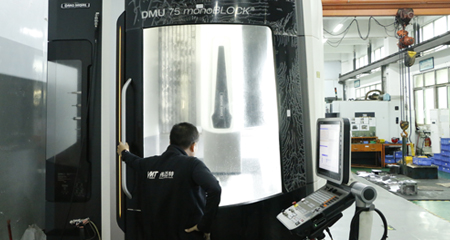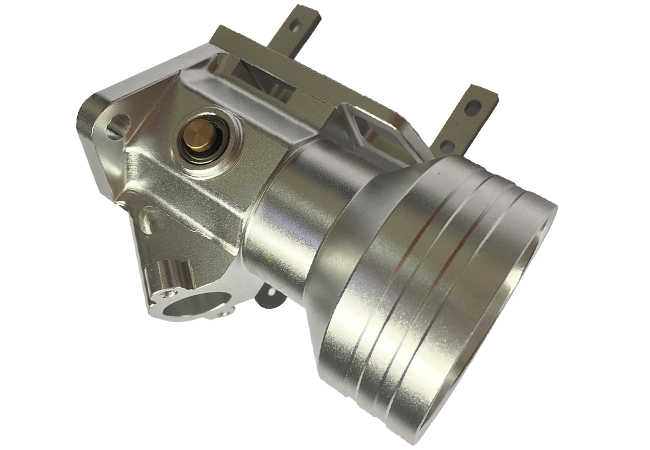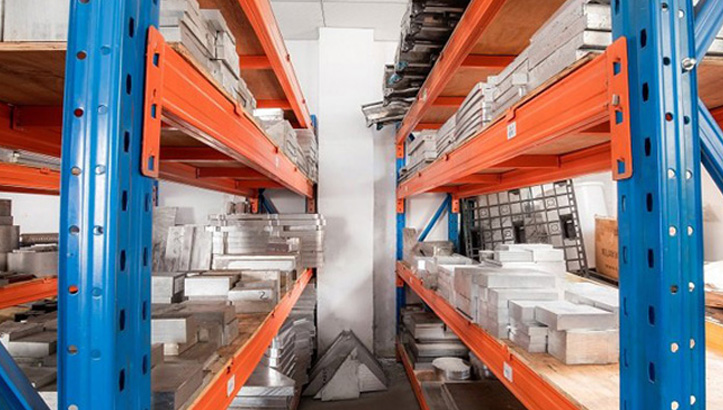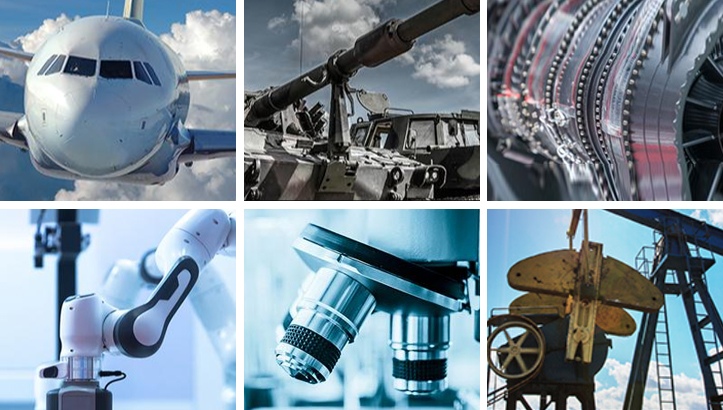The Benefits of 5-Axis CNC Machining
In traditional CNC machining, complex parts often demand multiple setups and are more prone to errors, leading to longer production times and higher costs. 5-axis CNC machining solves these challenges by enabling multi-directional cuts in a single setup, offering significant time and cost savings while improving precision and surface finish.
5-axis CNC machining utilizes five axes of movement (three linear and two rotary) to machine parts with high precision and at multiple angles. This eliminates the need for repositioning, reduces errors, and accelerates production, especially for complex geometries that would be difficult to achieve with traditional 3-axis CNC milling.
Now, let’s explore how 5-axis CNC works, its origins, the various benefits, and how it impacts industries like aerospace, automotive, and medical.
What is 5-Axis CNC Machining?
5-axis CNC machining refers to a type of computer numerical control (CNC) machining that utilizes five axes of movement to process materials. Unlike traditional 3-axis CNC machining, which only moves along three linear axes (X, Y, and Z), 5-axis CNC machining adds two additional rotary axes (usually called the A and B axes), allowing the machine tool to approach a workpiece from virtually any angle.

What are the 5 axis on a CNC Machine?
In 5 axis CNC machining, the term “five axes” refers to the five independent movements that a CNC machine tool can perform. These axes allow for precise and complex machining, enabling the tool to access the workpiece from multiple angles. This flexibility significantly enhances the machining capabilities compared to traditional 3-axis CNC machines, which are limited to movement along only three axes.
X, Y, Z Axes (Linear Movements):
These three axes form the foundation of any CNC machine’s movement. They control the basic, linear motions of the machine tool:
X-axis: Movement left to right (horizontal)
Y-axis: Movement front to back (horizontal)
Z-axis: Movement up and down (vertical)
These linear motions allow the cutting tool to move along the length, width, and height of the workpiece, providing the basic framework for machining.
A and B Axes (Rotary Movements):
In addition to the linear movements, 5 axis CNC machines incorporate two rotational axes, which provide added flexibility and precision:
A-axis: Rotation around the X-axis, typically enabling the workpiece or tool to tilt forward or backward.
B-axis: Rotation around the Y-axis, allowing the workpiece or tool to rotate from side to side.
These rotational movements enable the cutting tool to approach the workpiece from virtually any angle, giving the machine the ability to access difficult-to-reach areas and perform complex cuts that are impossible with a 3-axis machine.
What is 3+2 Axis Machining?
3+2 axis machining is a technique that combines the simplicity of 3-axis CNC with the flexibility of a fifth axis. In this setup, the tool remains fixed while the workpiece rotates, enabling machining at various angles without full rotational movement. While not as versatile as full 5-axis machining, 3+2 axis can be a cost-effective solution for certain parts, offering improved flexibility over traditional 3-axis methods.
3-axis vs 5-axis CNC Machining
3-axis CNC machining moves the tool along three linear axes (X, Y, Z), suitable for simpler, less complex parts. It’s cost-effective but may require multiple setups for intricate designs. In contrast, 5-axis CNC machining adds two rotational axes (A, B), allowing the tool and part to move simultaneously, enabling more complex geometries and higher precision in a single setup. While 5-axis machining is ideal for detailed and intricate parts, it is more expensive and requires advanced programming.
5-Axis – Where Did It Come From?
The origins of 5-axis CNC machining can be traced back to the limitations of early 3-axis CNC machines. Traditional 3-axis CNC machines were capable of moving along three linear axes (X, Y, and Z), which was sufficient for machining simple parts with basic geometries. However, as industries demanded more complex and precise parts, the limitations of 3-axis CNC became apparent.
In particular, the aerospace industry, with its need for intricate parts such as turbine blades, engine components, and other high-precision, geometrically complex pieces, faced challenges using conventional 3-axis machining. These parts often required the ability to cut from multiple angles and with extreme precision, something 3-axis CNC machines could not achieve effectively.
The Development of 5-Axis Machines
To overcome these challenges, manufacturers began developing machines with additional rotational axes—specifically the A-axis and B-axis. These axes allow the part or tool to rotate, enabling the machine to reach different angles without needing to reposition the workpiece or tool.
The first 5 axis CNC machines were primarily used in specialized applications like aerospace and defense. These industries required components with intricate designs and very tight tolerances. For instance, the production of turbine blades, with their complex contours, sharp edges, and variable geometries, could only be achieved effectively with multi-axis machining.
Why Use CNC for 5-Axis Machining?
The primary reason for using CNC in 5-axis machining is its ability to maintain high levels of accuracy and consistency. Unlike manual machining, where human error is a factor, CNC machines can produce parts with tight tolerances, ensuring uniformity across multiple units. CNC 5-axis machining allows for a higher level of automation, reducing human labor while improving part quality and reducing the chances of errors caused by repositioning or manual adjustments.

Additionally, 5-axis CNC machines are designed to work efficiently with complex parts, reducing the need for multiple setups, which not only saves time but also improves the overall quality of the final product.
What is a 5-axis CNC Machine?
A 5-axis CNC machine is a sophisticated, computer-controlled machine tool designed for high-precision manufacturing. It is capable of moving the cutting tool along five different axes simultaneously, providing unparalleled flexibility and the ability to machine highly complex parts with intricate geometries. This makes it an ideal choice for industries that require precision in the production of parts with complex shapes, such as aerospace, automotive, medical devices, and precision tooling.
The five axes of movement in a 5-axis CNC machine are typically:
- X-axis: The primary horizontal axis, moving left to right, which controls the position of the cutting tool relative to the workpiece.
- Y-axis: The secondary horizontal axis, moving front to back, allowing the cutting tool to approach the workpiece from different angles.
- Z-axis: The vertical axis, moving up and down, controlling the depth of the cut. This axis is often used in conjunction with the X and Y axes for 2D milling operations.
- A-axis: This is the rotational axis around the X-axis, allowing the workpiece or tool to rotate forward and backward. This rotation facilitates the machining of angled surfaces that would otherwise be difficult to access with a 3-axis machine.
- B-axis: The second rotational axis, rotating around the Y-axis. It provides the ability to position the workpiece or tool at any angle, enabling machining on complex surfaces that require multi-dimensional access.
How Does a 5-Axis CNC Machine Work?
A 5-axis CNC machine operates by controlling five independent axes of movement simultaneously, which gives it a unique ability to approach a workpiece from almost any angle. Here’s a breakdown of how it works:
Part Setup: The part is secured on the machine’s bed, and the software program specifies the tool paths based on the part’s design.
Tool Movement: The CNC controller sends instructions to the machine, moving the tool along the X, Y, Z axes. Simultaneously, the machine rotates the part around the A and B axes to achieve the desired cutting angle.
Continuous Rotation: As the tool moves in the three linear directions, the part rotates in real-time, enabling complex cuts to be made without the need for repositioning.
This continuous rotation and multi-axis movement allow for precise and detailed cuts that would be difficult or impossible with traditional 3-axis CNC machines.
What Materials Can Be Machined with 5-Axis CNC?
5-axis CNC machines are renowned for their versatility in processing a broad spectrum of materials. For metals, they can efficiently machine lightweight options like aluminum and magnesium for aerospace applications, durable steels for automotive and industrial parts, and high-strength, heat-resistant alloys like titanium and Inconel, which are commonly used in medical and energy sectors.

Beyond metals, 5-axis CNC machining handles plastics, composites, and advanced materials with equal precision. Thermoplastics such as ABS, nylon, and PEEK are often used for prototypes or lightweight components, while composites like carbon fiber and fiberglass are machined for high-strength, lightweight applications in automotive and sports industries. The adaptability of 5-axis machines allows manufacturers to work with exotic materials, ensuring compatibility with virtually any project requirement.
10 Benefits of 5-Axis CNC Machining
1. Higher Precision and Accuracy
5-axis CNC machining offers exceptional precision, often achieving tolerances as tight as ±0.01 mm. This level of accuracy is crucial for industries such as aerospace, medical, and automotive, where components with intricate geometries or critical performance requirements must meet exact specifications without any deviation.
2. Reduced Setup Time
Unlike traditional machining methods that require multiple setups for complex parts, 5-axis machines can perform all machining operations in a single setup. This minimizes manual intervention, reduces repositioning errors, and significantly cuts down setup time, resulting in enhanced operational efficiency.
3. Better Surface Finish
By allowing tools to approach the workpiece from optimal angles, 5-axis machining minimizes tool marks and produces smoother surfaces. This reduces the need for secondary finishing processes, which is especially important for parts that require polished or aerodynamic surfaces.
4. Cost-Effectiveness
While the initial investment in 5-axis machines may be high, the long-term cost savings are considerable. Fewer setups, shorter production cycles, and reduced tool wear result in lower labor and material costs, making 5-axis CNC machining a highly cost-effective choice over time.
5. Increased Efficiency and Productivity
The ability to machine complex parts in fewer operations dramatically reduces production time. With advanced programming and automation, 5-axis machines can operate continuously, boosting throughput. The cumulative time savings across production runs lead to significantly higher overall productivity.
6. Capability to Machine Complex Geometries
By maintaining optimal cutting angles throughout the machining process, 5-axis machines distribute cutting forces evenly, reducing heat and wear on tools. This not only extends tool life but also reduces the frequency of tool changes, leading to lower tooling costs and improved machine uptime.
7. Improved Tool Life and Durability
Maintaining optimal cutting angles during machining evenly distributes cutting forces, reducing heat and wear on tools. This extends tool life and reduces the frequency of tool changes, leading to lower tooling costs and improved machine uptime.
8. Material and Application Flexibility
5-axis CNC machines are highly versatile and can process a wide range of materials, from hard metals like titanium and stainless steel to softer materials like plastics and composites. This flexibility makes them suitable for custom, prototype, and high-volume production across various industries.
9. Consistency in High-Volume Production
Once programmed, 5-axis machines produce parts with identical precision and quality, ensuring consistent output with minimal variability. Their high repeatability and automation make them ideal for industries that require reliable, consistent results in high-volume manufacturing.
10. Versatility Across Industries
5-axis CNC machines are used across a wide range of industries, including aerospace, automotive, medical, and energy. Their ability to machine from multiple angles makes them perfect for producing complex components such as turbine blades, engine parts, medical implants, and wind turbine hubs, adapting to the evolving demands of these industries.
What are the Limitations of 5-Axis Machining?
While 5-axis machining offers significant advantages, it also has certain limitations that manufacturers should consider:
High Initial Cost: The purchase cost of a 5-axis CNC machine is significantly higher than that of 3-axis or 4-axis machines. Additional expenses include specialized software, installation, and operator training. These upfront investments can be prohibitive for small businesses or low-budget projects.
Complex Programming and Setup: Programming for 5-axis machining is more challenging and requires expertise in advanced CAD/CAM software. Additionally, setting up the machine for complex designs or parts with tight tolerances can be time-consuming and demand greater technical skill.
Steeper Learning Curve: Operating a 5-axis CNC machine requires extensive training for both operators and engineers to fully utilize its potential. Inexperienced operators may introduce programming errors or inefficient tool paths, leading to defective parts or longer production times.
Higher Maintenance and Operating Costs: Due to the complexity of 5-axis machines, maintenance requires more effort and incurs higher costs. The machines also consume more energy than simpler CNC systems, which increases operating expenses over time.
Limited Workpiece Size: Although 5-axis machines excel in handling complex geometries, their working envelope can limit the size of workpieces they can process. Larger components may require multiple setups or alternative machining methods, adding to production complexity.
Industries Using 5-Axis Equipment
5-axis CNC machining is especially valuable in industries where parts require high precision, complex geometries, and smooth finishes. These include:
1. Aerospace
The aerospace industry relies heavily on 5-axis CNC machining to manufacture critical components like turbine blades, airframes, engine parts, and satellite components. These parts often require a combination of lightweight materials, intricate geometries, and high strength to meet performance and safety standards. 5-axis machining enables precision manufacturing of complex shapes while maintaining consistency across production runs, which is essential for aerodynamics and efficiency.
2. Medical
In the medical industry, 5-axis CNC machining is indispensable for producing surgical instruments, implants (such as hip joints and dental crowns), and diagnostic equipment components. These parts must meet stringent standards for precision, surface finish, and sterilization compatibility. The ability to machine intricate geometries, such as bone-like structures or custom patient-specific devices, makes 5-axis technology a cornerstone in modern medical manufacturing.
3. Automotive
The automotive sector utilizes 5-axis machining for creating high-performance engine parts, chassis components, mold tools, and prototypes. Complex designs, tight tolerances, and high production volumes are common in automotive manufacturing, and 5-axis machines excel in meeting these demands. They also facilitate rapid prototyping, enabling faster development cycles for innovative designs in electric and autonomous vehicles.
4. Electronics
Electronics manufacturing benefits from 5-axis machining in the production of precision components like micro-connectors, housings, heat sinks, and enclosures for electronic devices. These components often involve detailed designs and small-scale features that require the precision and multi-angle accessibility of 5-axis machining.
5. Defense
The defense industry relies on 5-axis CNC machining for high-strength, complex parts used in military applications, such as aircraft components, missile systems, naval equipment, and armored vehicle parts. These parts must withstand extreme conditions and require a combination of durability, precision, and consistency that 5-axis machines provide.
6. Consumer Goods
In consumer goods manufacturing, 5-axis machining is used for producing premium products such as luxury watch components, eyewear frames, kitchen appliances, and sporting equipment. The combination of complex aesthetics and functional precision makes 5-axis CNC machines an ideal choice.
7. Tool and Die Making
The tool and die industry benefits from 5-axis machining for creating molds, dies, and tools with intricate designs and tight tolerances. This is critical for industries like injection molding and stamping, where the quality of the tool directly affects the quality of the end product.
8. Robotics and Automation
5-axis machining is used in robotics to manufacture parts like robot arms, grippers, and precision gears. These components require exacting tolerances to ensure smooth motion and reliability in automation systems, which are increasingly prevalent across industries.

In Conclusion
5-axis CNC machining offers significant advantages in terms of precision, efficiency, and versatility. By eliminating the need for multiple setups and allowing for complex geometries to be machined in a single operation, 5-axis CNC machines are revolutionizing industries like aerospace, automotive, and medical, providing cost-effective solutions without compromising quality.
Started Your Parts machining With 5 Axis Machining at VMT
VMT is one of the leading CNC machining service providers worldwide. Equipped with superior 5-axis CNC machines, we deliver top-notch parts, competitive pricing, and swift lead times.
Moreover, beyond 5-axis machining, we offer a variety of machining options and solutions tailored to your needs.
Frequently Asked Questions About 5-Axis CNC Machining
What is the Difference Between 5-axis and 6-axis Machining?
5-axis machining: Uses three linear axes (X, Y, Z) and two rotational axes (A, B). It is excellent for intricate, multi-sided parts.
6-axis machining: Adds a sixth axis (often rotational, like C), increasing flexibility and efficiency. It allows for even more complex machining tasks without repositioning the part.
How Much Does 5-axis CNC Machining Cost Per Hour?
5-axis CNC machining typically costs $75 to $150 per hour, depending on factors like machine type, material, and part complexity. High-precision jobs or specialized materials may incur higher costs, especially in advanced industries like aerospace.
What CNC Machine Has the Most Axes?
The CNC machines with the most axes can have up to 12 axes or more. These are advanced multi-axis machines, often used in high-precision industries like aerospace or automotive. They provide unparalleled flexibility for machining complex parts.
What is 5-Axis Machining?
5-axis machining refers to a process in which a CNC machine operates along five axes simultaneously, allowing for the creation of complex and precise parts. It is especially useful for aerospace, automotive, and medical industries, where intricate shapes with tight tolerances are required.
Unlike traditional 3-axis machining, 5-axis machining can access multiple sides of a part without needing to manually reposition it. This enables machining of complex features such as undercuts, curved surfaces, and multi-angle designs in a single setup, which increases productivity and precision.



